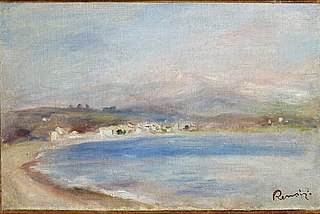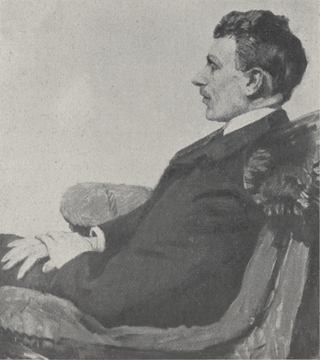External links
- (de) « van Diemen, Galerie » Archived 2018-03-09 at the Wayback Machine , site Stiftung Deutsches Zentrum Kulturgutverluste, 2017
- (en) Unter den Linden 41. Galerie Van Diemen, site Jüdisches Museum Berlin
Galerie van Diemen was a commercial art gallery founded in 1918 in Berlin (Germany), and which had branches in The Hague, Amsterdam and New York. [1] Under the Nazis, the German branch was Aryanized and its Jewish owners forced into exile and murdered. [2]
Originally specializing in Dutch painting, the Van Diemen Gallery organized in 1922 the first major exhibition of Russian avant-garde art in Europe since 1917. [3] The gallery was located at Unter den Linden 41.
Directors Eduard Plietzsch (1919-1935) and Kurt Benedict (1923-1933) headed the branches van Diemen and Dr. Benedict & Co. Until 1929 these two galleries, together with Altkunst Antiquitätene and Dr Otto Burchard & Co. belonged to Albert Loeske's Margraf group before being inherited by its employees Jacob and Rosa Oppenheimer. [4]
When the Nazis came to power in 1933, however, the Oppenheimer's were banned as Jews from managing the Margraf group, [5] which came under the control of a Nazi administrator named Bolko von Richthofen, "a zealous Nazi and close acquaintance of Herman Göring". [6]
The Berlin Galleries (van Diemen, Dr Benedict & Co., Dr Otto Burchard & Co and Altkunst Antiquitäten) were liquidated by the National Socialists in 1935 and the artworks auctioned off at the Paul Graupe auction house. [7]
Rosa and Jacob Oppenheimer fled to France in 1933 as refugees. Jakob died in Nice in 1941 and Rosa was interned in the French Drancy concentration camp, then deported to Auschwitz where she perished on 2 November 1943. [8]
In 1935, the New York branch merged with the Lilienfeld Gallery, under its founder Karl Lilienfeld, who had immigrated from Germany to New York. It was called the van Diemen-Lilienfeld Gallery until the mid-1960s. [9]
Numerous claims for restitution have been filed in connection with the Nazi persecution Galerie Van Diemen, the Oppenheimers and the Margraf group. A few include:
The Galerie van Diemen was first established in Berlin, c. 1918, with branches later opening in The Hague, Amsterdam and New York. The galleries were managed by Directors Eduard Plietzsch (from 1919-1935) and Kurt Benedict (from 1923-1933), who ran establishments under the names of van Diemen, Berlin, and Dr. Benedict & Co., Berlin, respectively. The establishments, as well as two other galleries, Altkunst Antiquitäten and Dr. Otto Burchard & Co., were under an umbrella organization, the Margraf Concern, owned by Albert Loeske until 1929, when it passed to long time employees Jacob and Rosa Oppenheimer. Initially specializing in Dutch painting, in 1922 the Galerie van Diemen organized the first important Russian Avant-Garde exhibition to be held in Europe since the 1917 Revolution. In 1935 the Berlin branches (van Diemen, Dr. Benedict & Co., Dr. Otto Burchard & Co.; Altkunst Antiquitäten) were liquidated by order of the Nazis, with sales organized by Graupe on 25 January and 26 April. The New York branch became associated at about that time with the Lilienfeld Gallery, originally established in Germany by Karl Lilienfeld (b. 1885) and was known until the mid-1960s under the name van Diemen-Lilienfeld
Altkunst Antiquitäten, the Berlin art gallery that owned the tapestry, was a subsidiary of Margraf and Co., a group of art dealerships run by Jakob and Rosa Oppenheimer. In 1933, the Oppenheimers, who were Jewish, fled Germany to escape Nazi persecution and relocated to France. In their absence they were forced out of the management of Margraf and Co. and were forbidden by court order from conducting any legal transactions for the company. The Nazi regime appointed an Aryan administrator who was a close associate of Hermann Göring to dissolve the Margraf dealerships. The gallery stock, including this tapestry, was quickly sold off in a series of auctions held in Berlin in 1935 that are considered forced liquidation sales.
On December 2nd, 1933 a Berlin Nazi Court banned the Oppenheimers from being directors of Margraf & Co. and Bolko von Richthofen, a zealous Nazi and close acquaintance of Herman Göring, was appointed administrator of the group.
In 1935 the Berlin branches (van Diemen, Dr. Benedict & Co., Dr. Otto Burchard & Co.; Altkunst Antiquitäten) were liquidated by order of the Nazis, with sales organized by Graupe on 25 January and 26 April.
Das jüdische Unternehmerpaar Jakob und Rosa Oppenheimer zählt zu den Verfolgten im Nationalsozialismus in Deutschland. Sie waren Ende März 1933 durch die Flucht nach Frankreich nur knapp ihrer Verhaftung entgangen. Jakob Oppenheimer verstarb 1941 in Nizza. Seine Frau wurde nach dem Einmarsch der deutschen Truppen in das Lager Drancy interniert, nach Auschwitz deportiert und dort 1943 ermordet. Rosa Beer blieb trotz der sich verschärfenden Lebensbedingungen für Juden in Berlin. Sie wurde nach Theresienstadt deportiert, wo sie 1943 ebenfalls ermordet wurde. Mit Datum der Deportation galt ihr Vermögen als an den Staat verfallen.
Dr. Karl Lilienfeld immigrated to New York from Germany in 1925 and founded his eponymous gallery there the same year. In November 1932 there was an announcement that Dr. Lilienfeld would "continue to conduct" the Lilienefeld Galleries at 21 East 57th Street and would also "act as general representative" for Van Diemen Galleries, New York. In 1935 the Van Diemen Galleries, Berlin headquarters were liquidated by the National Socialists (Nazis). Around 1936 the New York branch of Van Diemen Galleries became the Van Diemen-Lilienfeld Galleries with Dr. Lilienfeld the director of the merged venture. The gallery was recognized as the Van Diemen-Lilienfeld Galleries until the early 1960s.
BOYNTON BEACH, FL -- At 73, Peter Bloch's memories of his grandparents are faint. The Boynton Beach retiree last saw them in Germany in 1940, when he was 5 and they were about to be interned in a Nazi concentration camp. But Jakob and Rosa Oppenheimer will be indelible in Bloch's mind today during ceremonies in Sacramento, Calif., when Italian Renaissance paintings that the Nazis looted from the couple prior to World War II are returned to his family. For decades the three works have hung on the walls of the state-run Hearst Castle in San Simeon.

The Neue Galerie New York is a museum of early twentieth-century German and Austrian art and design located in the William Starr Miller House at 86th Street and Fifth Avenue in New York City. Established in 2001, it is one of the most recent additions to New York City's famed Museum Mile, which runs from 83rd to 105th streets on Fifth Avenue in the Upper East Side of Manhattan.

Otto Müller was a German painter and printmaker of the Die Brücke expressionist movement.

The Saarland Museum is an art museum in Saarbrücken, Saarland, Germany. It is spread across three sites, each with a different specialism.

Isaac de Jouderville, was a Dutch Golden Age painter who was a pupil of Rembrandt.

The Coast at Cagnes, Sea, Mountains, is a 1910 painting by Pierre-Auguste Renoir representing his late work period (1892–1919). It was bequeathed by Leopold Moller in 1999 to the Friends of Bristol Art Gallery who passed it to Bristol City Council for display in Bristol Museum.
Eduard Plietzsch was a German art historian and dealer investigated in connection to Nazi-looted art.
Fritz Nathan was a German-Swiss gallery owner and art dealer.
Rosa Oppenheimer was a German Jewish art dealer who was murdered in the Holocaust. The art she owned together with her husband Jacob is the subject of several high-profile restitution claims.
The Galerie Nierendorf is a commercial art gallery based in Berlin founded by Karl and Josef Nierendorf in 1920, and reopened in 1955 as the Galerie Meta Nierendorf by Florian and Inga Karsch.

The art collection of Ismar Littmann (1878–1934), a German lawyer who lived in Breslau, comprised 347 paintings and watercolors and 5,814 drawings from artists such as Lovis Corinth, Max Pechstein, Erich Heckel, Max Liebermann, Käthe Kollwitz, Lucien Adrion, and Otto Mueller.
Max Silberberg was a major cultural figure in Breslau, a German Jewish entrepreneur, art collector and patron who was robbed and murdered by the Nazis. His art collection, among the finest of its era, has been the object of numerous restitution claims.
Karl Buchholz was one of Hitler's Nazi art dealers specialized in selling looted "Degenerate Art".

Leo Lewin was a German merchant, art collector and horse breeder who was persecuted by the Nazis due to being Jewish.
Hugo Simon was a German Jewish banker, politician and art collector who was persecuted by the Nazis. He was a former owner of Edvard Munch's famous painting, The Scream. After the November Revolution of 1918, he was briefly Minister of Finance in the Prussian Council of People's Representatives as a member of the USPD. Alfred Döblin dealt with this short time as a politician in his novel November 1918.
Günther Franke was a German gallery owner, art dealer and collector.
Benno Griebert was a German art historian and art dealer, and an early member of the Nazi party.

Alfred Gold was an Austrian writer, theatre critic, journalist, art collector, and dealer.

Paul Graupe was a German antiquarian bookseller and art dealer.

Franz Josef Kohl-Weigand was a German businessman, art collector and philanthropist.